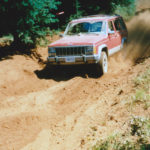The first and most important lesson you need to learn about driving on difficult terrain is that, except in very specific situations, using more throttle is going to create problems. A tire that is spinning is not going to grip the surface effectively, and a fast spinning tire that suddenly gains traction will put a potentially damaging amount of strain on your axles.
Second thing you need to learn is that if you can't see the entire hill clearly, have any doubt about what is immediately after it, or if the terrain is particularly challenging, you should get out and walk the section of trail before attempting it. From on foot you can better see where the hazards are and either choose a line that avoids them, or maybe even realize that trying to go further is a bad idea.
Take challenging sections one vehicle at a time. There is nothing worse than not making it up a hill only to find that you can't maneuver for another attempt because you have another rig stuck right behind you.
One of the most common hazards on back roads is a low traction hill climb. Whether the traction issue is caused by soft dirt, loose rock, or mud, the basic technique is the same. Start by assessing what gear you want to be in. Shifting on a hill will cause a momentary loss of momentum and then a sudden surge of power, both of which can get you stuck. this is especially true of standards, but still applies to automatics. You want to approach the climb at a speed that will allow you to carry some momentum up the hill and try to gently (very gently) accelerate as you climb. If you feel the tires start to spin then ease off the gas just enough to let the tires grab the surface again, then resume gentle acceleration. If you ease off the gas a bit and the tires don't bite then try gently accelerating again while rocking the steering wheel side to side about 1/2 turn to wiggle the front tires left and right. This can help find a spot with more traction, get the edges of your tread to grab, and temporarily reduce the angle your front tires are climbing. If you get stopped do NOT let your tires dig holes. It will make it harder to restart (up or down) and damages the climb for the next person. Always pay attention to the condition of the trail ahead of you so you can plan for a small bit of extra acceleration on areas with good traction and be ready to ease off the gas in areas with poor traction. When the front tires reach the top let off the gas enough to coast over the top of the hill, not launch over it Dukes of Hazard style.

A near-stock Jeep Cherokee zips up a silty hill without any problems. 90% of the drivers in this group used too much throttle, lost traction, dug into the silt, and got stuck. Fortunately there was an alternate route that goes around the hill. Never drive down something like this if you aren't sure you can get back up it, and vice-versa!
4-Low and first gear were used to control this descent. Not only is this a place where you do not want to lock up the tires and lose steering, the front driver side tire in in a trench and the suspension on the back passenger side is fully extended to the point that the tire is almost off the ground. Hitting the brakes at this point could shift the weight of the vehicle rapidly enough to cause it to tip over.
Great, you made it up the hill…now it’s time to come back down. If you ride your brakes too hard you can lock up your front tires, and a tire that is not turning is not controlling your decent or steering. Instead use the braking power of your engine and gearing to help control your speed. With an automatic transmission you will want to be in first gear. With a standard transmission it will vary by vehicle, but second gear is a good place to start. You are actually better off having a bit too much engine braking and need to press the gas slightly than to use the brakes too much. If you press the brakes and the front tires lock up you MUST ease off them. Better to be going a bit faster than you would like than to lose control and go off the trail or have the tail push out and risk rolling. As with climbing, look ahead and plan for a bit of extra braking where the traction is good and roll though sections with poor traction.
So you didn't make it! Now what?
First off, as soon as you lose your forward momentum you need to stop spinning your tires so you don't dig holes that will cause you even more problems.
With a standard transmission simply move your right foot from the gas to the brake and let the engine stall. It seems counterintuitive to what you learned about driving on-road, but it is the most controlled method of coming to stop, as both your brakes and your gears will be holding you against the slope.
With an automatic transmission apply the brake with your left foot as you get off the gas. This prevents roll-back and keeps you in control. Do NOT put the vehicle in Park.
Next, unless you are sliding backwards, dangling off the edge of the trail, or otherwise in immediate danger, the best thing you can do is engage the parking brake and take a minute to relax and asses the situation.
Only try to recover from a failed hill climb if you are 100% sure you have the traction to control your rig, otherwise either back all the way down or switch to a recovery plan.
- Why did you get stuck? Was it simply a traction issue or did you hit a rock or other obstacle that could be moved or avoided?
- What is immediately in front and behind you? Could you back up a few inches and then pop over the spot you got stuck and reach better ground? If you have spun your tires and built up a mound of dirt behind your tires you either want to back up onto the mound or back up clear of it. Putting that mound immediately in front of your tires will only cause you more problems.
- Is your tire pressure too high? In a pinch most tires can go down to 10 PSI, just remember that until you can raise the tire pressure you are restricted to crawling speed or you risk pulling a tire off the wheel.
- Can you back down safely? Assess how much traction you have, how difficult it will be to keep on the trail, and what obstacles you need to avoid. NEVER NEVER NEVER try to turn around on a hill. Turning sideways to a hill is a recipe for a roll-over. As with driving forwards down a hill, locking up your tires is the worse thing you can do.
- Can you be pulled upwards? Is there a way for another vehicle to hook to you, or is a winch or come-along available?
- Don't be afraid to ask for help! if there is a more experienced driver in your group ask them for advice. If you are getting flustered or are way out of your skill level you may even want to get them to drive your rig clear of the spot that gave you trouble.
But what if you are in danger of sliding backwards or are already sliding? Get your rig into reverse! Sliding in a forward gear or with the brakes locked you have no control over your rig, and as scary as it may be you are better to be going fast but have steering than to be sliding going slower. With an auto transmission just tap the brakes and shift to reverse, then get off the brakes again. With a standard transmission on most hills you can do the same, just depress the clutch for as short a time as possible. Ideally on super steep hills with a standard is simply let it stall, then shift to reverse without clutching and let the engine re-start (you may need to press a clutch by-pass button for the engine to start).


